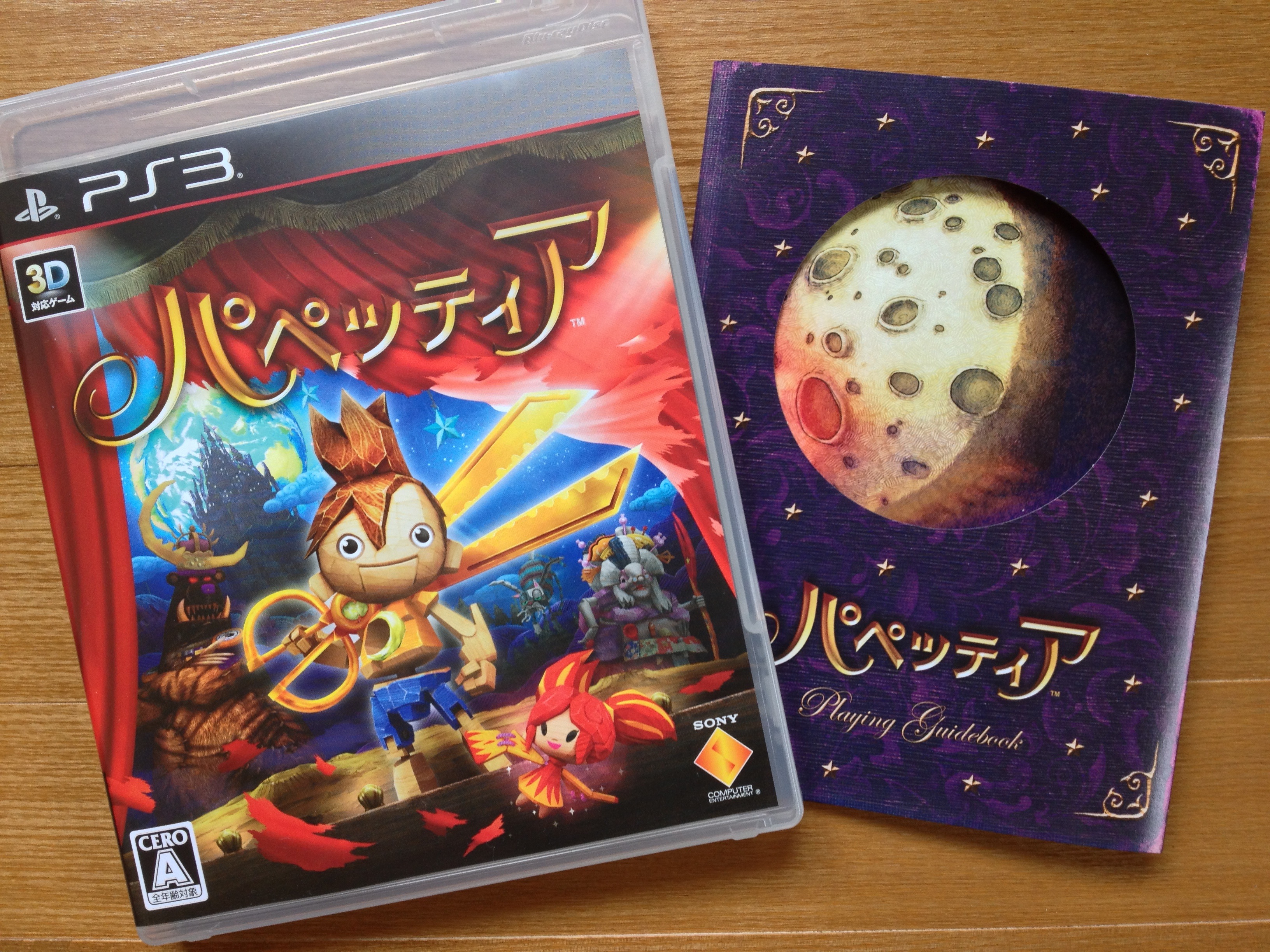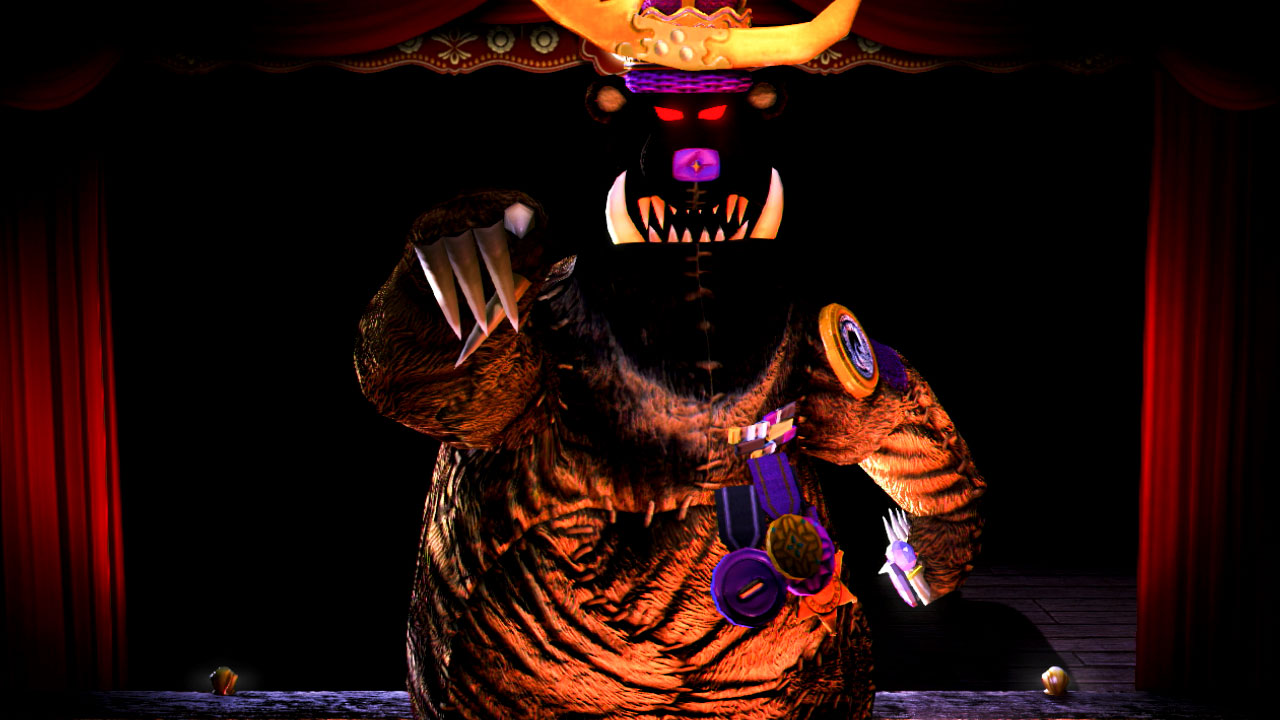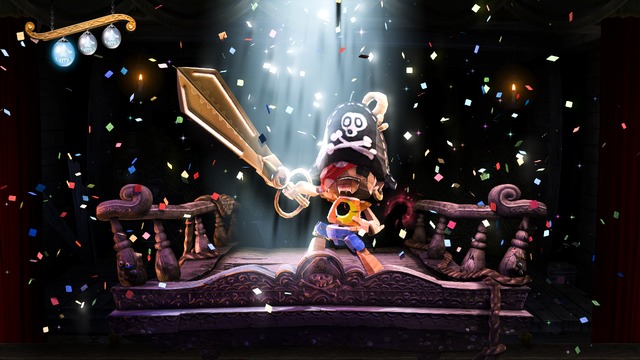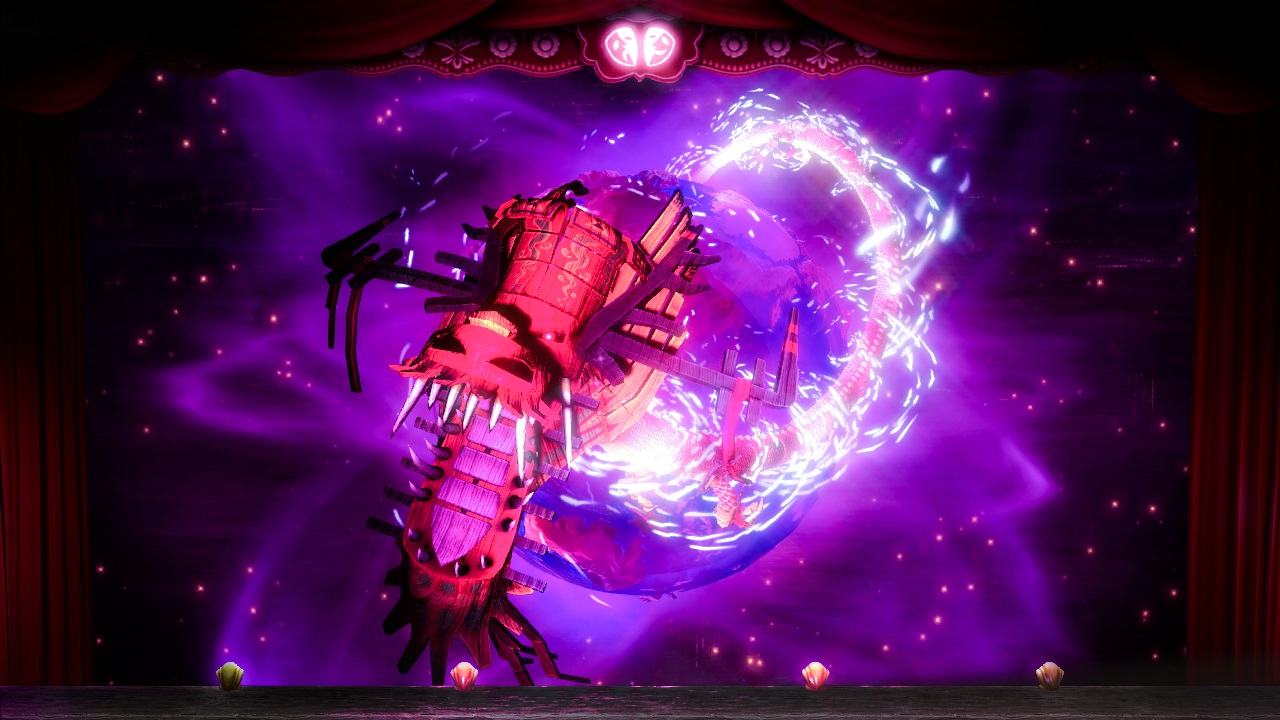
We have to admit we fell quite in love with Puppeteer‘s visual style from the very first moment we saw it. Although essentially a 2-D platformer, the game is presented as a live puppet show, heavily influenced by Japanese Bunraku puppet theatre, with a healthy dose of pantomime thrown in for good measure, and it looked positively spellbinding.
Due to go on sale both on disc and as a digital download via PlayStation Store in North America and Europe this week, the game was in fact released in Japan on September 5, so naturally we rushed out to grab a copy right away. Three days of platforming, applause and magical scissor snipping later, we’re delighted to say that Puppeteer is not just a superb platformer, but one of PlayStation 3’s most inspired titles to date.
Developed by Sony’s own Japan Studio, the people who brought us such digital delights as Ape Escape and more recently Gravity Rush on PlayStation Vita, Puppeteer is without a doubt one of the most quirky and original games yet to appear on Sony’s now somewhat ageing home platform.
The game tells the story of Kutaro, a young boy from earth who, after having his soul snatched by the nefarious and self-styled Moon Bear King, is transformed into a wooden puppet and has his head torn off, leaving him to find anything – a slice of cake, a wooden monkey head, a miniature blossoming cherry tree – to use as a substitute bonce in order to live out his remaining days working in the castle kitchens. It is here, however, that the terrified tyke encounters and is immediately quested by the bad-tempered Moon Witch (who is herself now relegated to cooking and washing dishes) with recovering her once prized possession – a pair of giant, magical scissors known as Calibus.
Once stolen, these shimmering blades become the game’s main platforming mechanic, allowing the player to travel by – as well as running and jumping of course – snipping through the beautiful hand-made stage sets, slicing through curtains, cloth and clouds, and literally attacking their enemies at the seams.
The real magic of Puppeteer, however, lies in its utterly enchanting presentation. The entire adventure, which takes place over seven “acts” each with three stages or “curtains”, is dramatically and professionally narrated from start to finish. The levels are built in real-time, with sets popping up and slamming into place on the stage as Kutaro progresses, a dramatic live soundtrack accompanied by explosions of smoke and confetti as he battles his way towards a showdown with each of the evil King’s many animal “generals”. Ever aware of itself and never shy of breaking the fourth wall, Puppeteer‘s characters talk to the audience (both the chorus of invisible but always audible theatre goers and the person holding the controller), bicker with one another and make numerous cultural references, even giving a cheeky nod to popular action adventure title InFamous that is sure to put a smile on PlayStation fans’ faces. The game is a veritable tour de force of platform adventure, launching the mute protagonist and his smart-mouthed but ultimately loveable companion Pikerina into colourful sets based on everything from the pirate seas and grave yards home to a disenfranchised Dracula, to time warps in outer space itself and steeplechases in deserts of Mexico. The audience – recorded during a live production at a London theatre, no less – gasps, applauds, shrieks and laughs throughout, all serving to pull the player into a genuinely enchanting platforming experience.
Visually, the game positively shines, showing once again that even in a market flooded with ultra-realistic first-person shooters and vast, open-world adventures, that two-dimensional platforming is far from dead. Spotlights constantly follow main characters – the hero, Kutaro’s, of course being the brightest – and the theatre’s curtains remain in view throughout the entire game, rippling and flapping as multi-layered stage sets that look somewhere between LittleBigPlanet and any number of Tim Burton movies drop into place.
Although we played the game on a regular, 2-D monitor, Japan Studio has stated that the game was built from the ground up with 3-D in mind, and, owing to the fact that the camera angle never changes and is always fixed on the “stage”, has managed to achieve some of the crispest and most effective 3-D yet seen on PlayStation 3. We have yet to try it for ourselves, but we have to admit that, when we weren’t snipping like crazy or actually laughing out loud at the game’s razor-sharp wit, we repeatedly took note of the myriad creatures and sets zipping out in front of the digital stage and saying, “I bet this looks amazing in 3-D!”
Veteran gamers will likely breeze their way through Puppeteer in little over eight to nine hours, and even younger players will eventually overcome even its trickier sections. Far from being a disappointment, however, in many ways the game’s leniency works in its favour. Holding the player’s hand only as far as the first few curtains, the game presents platforming puzzles that are both easy yet satisfying to overcome, leaving plenty to for completionists to find and unlock beyond the main adventure. Puppeteer is a title that is made to be seen, experienced and enjoyed from the opening curtain to the last hurrah, and as such presents an entertaining, visually stunning and shamelessly playful adventure that every PlayStation 3 owner should embark on at least once.
Highly recommended.
Puppeteer is on sale now in Japan and available from September 10 in North America and September 11 in Europe.
Top image: RocketNews24
All other images via Sony




 Countdown to PlayStation 4 in Japan – Mr. Sato heads to the Sony Building to join the fun
Countdown to PlayStation 4 in Japan – Mr. Sato heads to the Sony Building to join the fun Newsflash: Sony unveils “Project Morpheus”, new virtual reality headset for PlayStation 4
Newsflash: Sony unveils “Project Morpheus”, new virtual reality headset for PlayStation 4 Upcoming Vita game Murasaki Baby is delightfully dark and cute in equal parts 【GIFs】
Upcoming Vita game Murasaki Baby is delightfully dark and cute in equal parts 【GIFs】 Disaster video game series resurrected with support from the Kobe Fire Department
Disaster video game series resurrected with support from the Kobe Fire Department The new PlayStation VR comes with an adorable miniature PlayStation 4
The new PlayStation VR comes with an adorable miniature PlayStation 4 Red light district sushi restaurant in Tokyo shows us just how wrong we were about it
Red light district sushi restaurant in Tokyo shows us just how wrong we were about it Japanese ramen restaurants under pressure from new yen banknotes
Japanese ramen restaurants under pressure from new yen banknotes Beautiful Red and Blue Star luxury trains set to be Japan’s new Hokkaido travel stars
Beautiful Red and Blue Star luxury trains set to be Japan’s new Hokkaido travel stars Pokémon Sleep camping suite and guestrooms coming to Tokyo Hyatt along with giant Snorlax burgers
Pokémon Sleep camping suite and guestrooms coming to Tokyo Hyatt along with giant Snorlax burgers Tokyo Tsukiji fish market site to be redeveloped with 50,000-seat stadium, hotel, shopping center
Tokyo Tsukiji fish market site to be redeveloped with 50,000-seat stadium, hotel, shopping center We tried Korea’s way-too-big King Tonkatsu Burger at Lotteria 【Taste Test】
We tried Korea’s way-too-big King Tonkatsu Burger at Lotteria 【Taste Test】 French Fries Bread in Tokyo’s Shibuya becomes a hit on social media
French Fries Bread in Tokyo’s Shibuya becomes a hit on social media Secret Kitchen bento serves Japanese flowers, birds, wind and moon in a box, but is it worth it?
Secret Kitchen bento serves Japanese flowers, birds, wind and moon in a box, but is it worth it? McDonald’s new Happy Meals offer up cute and practical Sanrio lifestyle goods
McDonald’s new Happy Meals offer up cute and practical Sanrio lifestyle goods Mt. Koya planning to instate visitor’s tax to cope with huge tourist numbers
Mt. Koya planning to instate visitor’s tax to cope with huge tourist numbers All-you-can-drink Starbucks and amazing views part of Tokyo’s new 170 meter-high sky lounge
All-you-can-drink Starbucks and amazing views part of Tokyo’s new 170 meter-high sky lounge More foreign tourists than ever before in history visited Japan last month
More foreign tourists than ever before in history visited Japan last month Studio Ghibli releases new action figures featuring Nausicaä of the Valley of the Wind characters
Studio Ghibli releases new action figures featuring Nausicaä of the Valley of the Wind characters New private rooms on Tokaido Shinkansen change the way we travel from Tokyo to Kyoto
New private rooms on Tokaido Shinkansen change the way we travel from Tokyo to Kyoto Starbucks reopens at Shibuya Scramble Crossing with new look and design concept
Starbucks reopens at Shibuya Scramble Crossing with new look and design concept Studio Ghibli glasses cases let anime characters keep an eye on your spectacles
Studio Ghibli glasses cases let anime characters keep an eye on your spectacles Beautiful Ghibli sealing wax kits let you create accessories and elegant letter decorations【Pics】
Beautiful Ghibli sealing wax kits let you create accessories and elegant letter decorations【Pics】 Studio Ghibli releases Kiki’s Delivery Service chocolate cake pouches in Japan
Studio Ghibli releases Kiki’s Delivery Service chocolate cake pouches in Japan New definition of “Japanese whiskey” goes into effect to prevent fakes from fooling overseas buyers
New definition of “Japanese whiskey” goes into effect to prevent fakes from fooling overseas buyers Our Japanese reporter visits Costco in the U.S., finds super American and very Japanese things
Our Japanese reporter visits Costco in the U.S., finds super American and very Japanese things Studio Ghibli unveils Mother’s Day gift set that captures the love in My Neighbour Totoro
Studio Ghibli unveils Mother’s Day gift set that captures the love in My Neighbour Totoro New Japanese KitKat flavour stars Sanrio characters, including Hello Kitty
New Japanese KitKat flavour stars Sanrio characters, including Hello Kitty New Pokémon cakes let you eat your way through Pikachu and all the Eevee evolutions
New Pokémon cakes let you eat your way through Pikachu and all the Eevee evolutions Disney princesses get official manga makeovers for Manga Princess Cafe opening in Tokyo
Disney princesses get official manga makeovers for Manga Princess Cafe opening in Tokyo Sales of Japan’s most convenient train ticket/shopping payment cards suspended indefinitely
Sales of Japan’s most convenient train ticket/shopping payment cards suspended indefinitely Sold-out Studio Ghibli desktop humidifiers are back so Totoro can help you through the dry season
Sold-out Studio Ghibli desktop humidifiers are back so Totoro can help you through the dry season Japanese government to make first change to romanization spelling rules since the 1950s
Japanese government to make first change to romanization spelling rules since the 1950s Ghibli founders Toshio Suzuki and Hayao Miyazaki contribute to Japanese whisky Totoro label design
Ghibli founders Toshio Suzuki and Hayao Miyazaki contribute to Japanese whisky Totoro label design Doraemon found buried at sea as scene from 1993 anime becomes real life【Photos】
Doraemon found buried at sea as scene from 1993 anime becomes real life【Photos】 Tokyo’s most famous Starbucks is closed
Tokyo’s most famous Starbucks is closed One Piece characters’ nationalities revealed, but fans have mixed opinions
One Piece characters’ nationalities revealed, but fans have mixed opinions We asked a Uniqlo employee what four things we should buy and their suggestions didn’t disappoint
We asked a Uniqlo employee what four things we should buy and their suggestions didn’t disappoint Princesses, fruits, and blacksmiths: Study reveals the 30 most unusual family names in Japan
Princesses, fruits, and blacksmiths: Study reveals the 30 most unusual family names in Japan Meet the real Revolver Ocelot and check out his awesome Metal Gear cosplay/gunplay 【Videos】
Meet the real Revolver Ocelot and check out his awesome Metal Gear cosplay/gunplay 【Videos】 PlayStation 4 gets a price drop in Japan this October, Project Morpheus given an official name
PlayStation 4 gets a price drop in Japan this October, Project Morpheus given an official name We played RESIDENT EVII, aka Bioha7ard, aka Resident Evil 7, at Tokyo Game Show
We played RESIDENT EVII, aka Bioha7ard, aka Resident Evil 7, at Tokyo Game Show Porco Rosso punching puppets bring anime rivalry to life in beautiful way
Porco Rosso punching puppets bring anime rivalry to life in beautiful way Nintendo’s New Super Mario Bros. U Deluxe ad blends fantasy and reality, scores a 1UP
Nintendo’s New Super Mario Bros. U Deluxe ad blends fantasy and reality, scores a 1UP Anime’s hottest scriptwriter makes the move to puppet theater for his newest project 【Video】
Anime’s hottest scriptwriter makes the move to puppet theater for his newest project 【Video】 Attack on Titan game reveals new characters, story details
Attack on Titan game reveals new characters, story details So long, PlayStation 4 – Sony announces it’s ending repair service for early PS4 models
So long, PlayStation 4 – Sony announces it’s ending repair service for early PS4 models No console? No problem! Sony tests streaming video games direct to TV sets
No console? No problem! Sony tests streaming video games direct to TV sets Are you ready to watch the first music performance broadcast via PlayStation??
Are you ready to watch the first music performance broadcast via PlayStation?? You can drive this car with a PlayStation controller, meaning Gran Turismo is now real【Video】
You can drive this car with a PlayStation controller, meaning Gran Turismo is now real【Video】 “Nintendo president assassinated by Freemasons” conspiracy theory floats around social networks
“Nintendo president assassinated by Freemasons” conspiracy theory floats around social networks Sword Art Online: Hollow Realization Game’s 3rd TV Ad Streamed
Sword Art Online: Hollow Realization Game’s 3rd TV Ad Streamed Konami wants videos of you playing horror title P.T. for this year’s Tokyo Game Show
Konami wants videos of you playing horror title P.T. for this year’s Tokyo Game Show
Leave a Reply